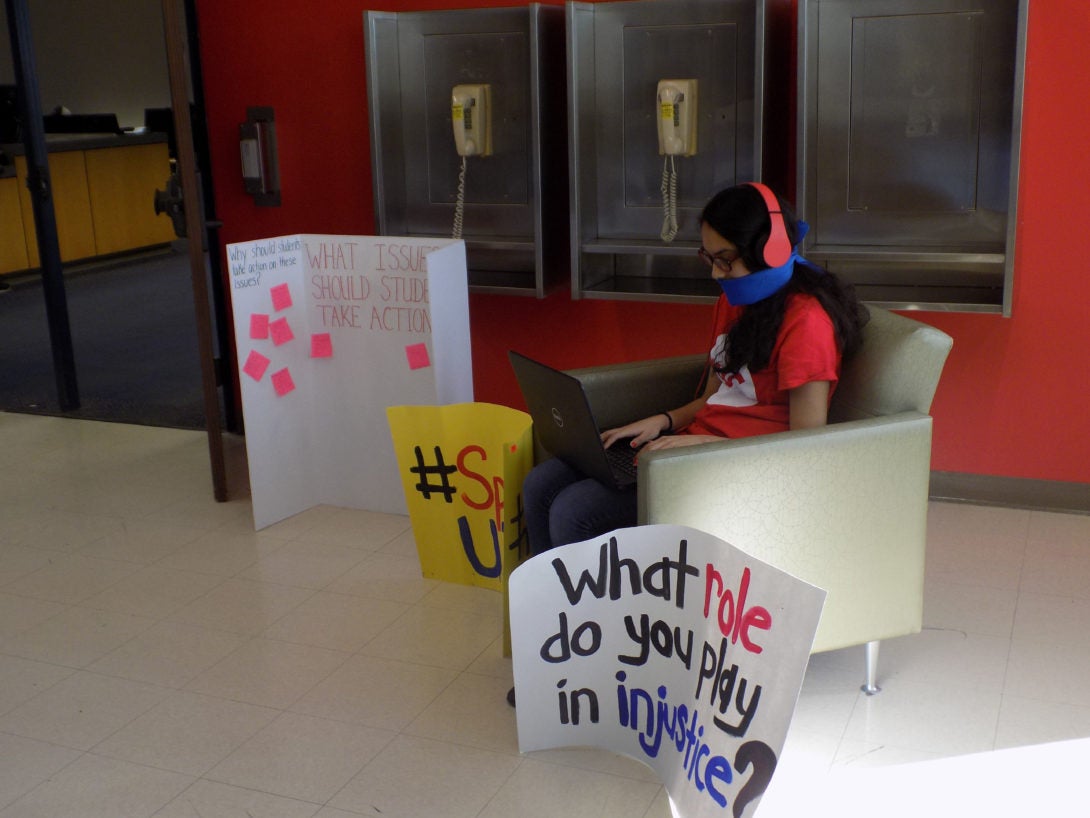Students Must Speak Up!
LaCreshia Brits, Anisha Chandran, Lana Hishmeh, Viviana Uribe
Overview of intervention: College students have played a vital role in creating social change. Often times, they are the main drivers of social movements and on-the-ground initiators of new policy. When students use their activism to direct attention to issues on their own campuses, they can be very successful. According to Dr. Lori Barcliff Baptista, Director of the African American Cultural Center, every cultural center at the University of Illinois-Chicago was created because of student organizing. On October 31, 2017, as an extension of the Honors class "Pedagogies of Protest," two student groups simultaneously staged protest interventions at UIC's Student Center East. Their goals were to engage their fellow students around social injustices. They did so by using their bodies and signs to create stimulating visuals that were hard to turn away from. This was in homage to the "irresistible image"- a concept used in Larry Bogad's "Tactical Performance"video and Anusha Kedhar's ideas around choreography and gestures at protests. Despite a difference in themes, both groups conveyed one unilateral message: students must speak up!
Intervention A Heading link

Intervention A: This intervention was designed by LaCreshia Birts and Viviana Uribe. It engaged students around issues of injustice by employing interactive, unbiased, and unconventional protest methods. To entice their audience, Birts encouraged students to pay attention to Uribe who was sitting in a chair with her mouth tied, her ears covered, and her eyes fixed on a laptop. The image was in reference to a popular song saying, “See no evil. Hear no evil. Speak no evil.” For Birts and Uribe, this concept represented how students appeared when they decided to stay out of social issues. The pair wanted students to be more aware of their behavior and to become more active against injustice. To amplify their message, Uribe sat amidst signs that prompted students to speak up and think about their role in injustice. Once students seemed captivated by the scene, Birts asked them to answer questions about which issues they felt were worthy of attention and why and how students should take action. Students were also encouraged to use the hashtag: #SpeakUpUIC to extend the conversation.
Intervention B Heading link
Intervention B: Anisha Chandran and Lana Hishmeh conducted this intervention. It specifically focused on consumerism. The protesters wanted students to understand how their clothes and purchases impacted industries and affected people beyond them. To convey this message, Hishmeh dressed in a trendy outfit and help up a sign that read:” This outfit costs $15 and my life.” Meanwhile, Chandran who was dressed in black, represented the worker making the outfit. They encouraged students to visit a website to learn more and share their image with others.
Comparable protests: Students Protest Against Trump Visit at UIC
An important event that relates to this particular set of student interventions is the series of protests held against Donald Trump’s visit to the UIC Pavilion in March 2016.
As these and other “irresistible images” illustrate, UIC students and other activists gathered inside and outside of the UIC Pavilion to prevent then presidential front runner to spread his divisive messages to the UIC students, personnel, stakeholders and community allies.